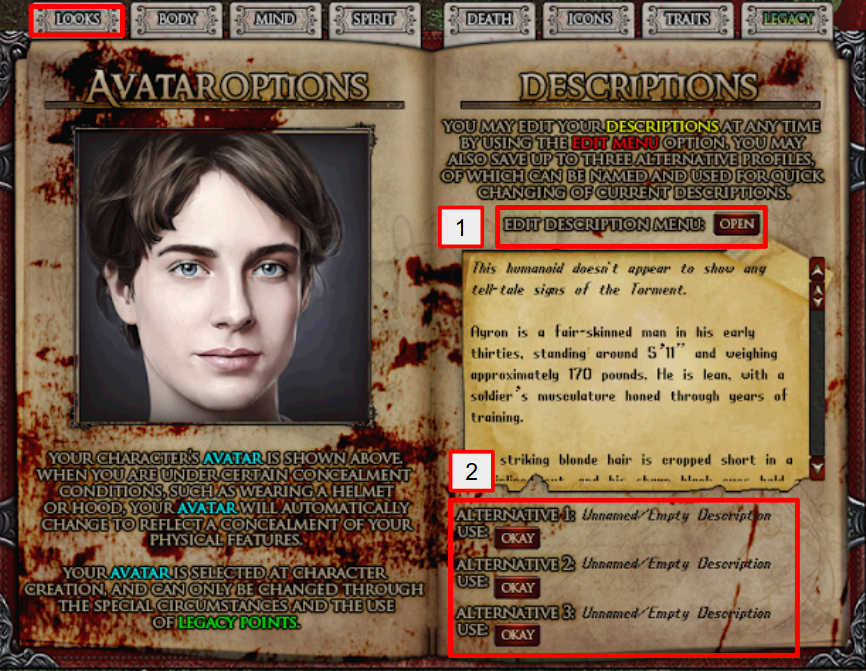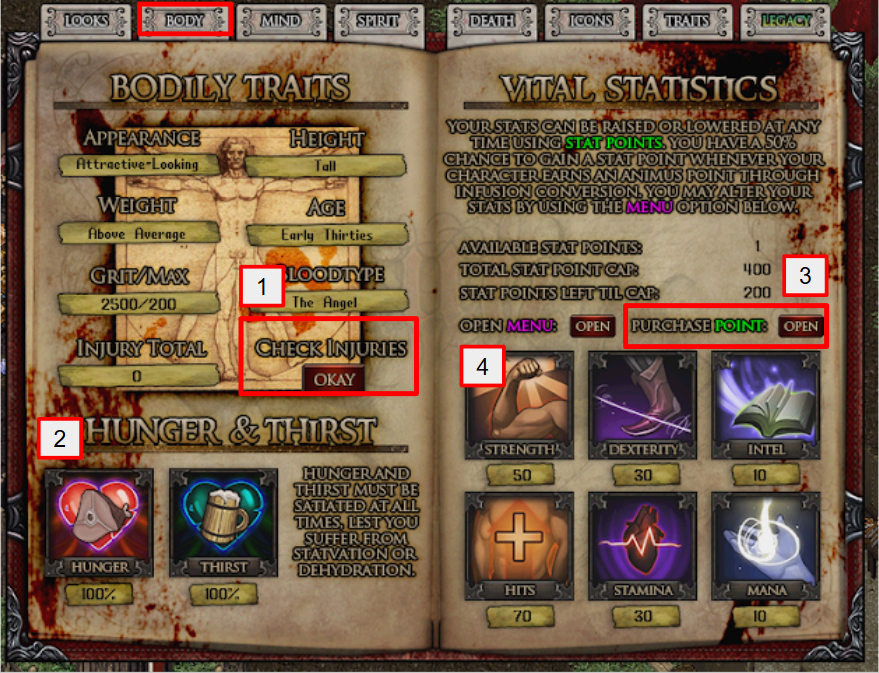This is an old revision of the document!
Codex
The Codex – Your Living Character Journal The Codex is not just another UI panel—it is your character’s in-world diary, a complete record of who they are, what they’ve endured, and how they evolve. Designed to be used both mechanically and in-character, the Codex contains vital information that every player must regularly check and understand.
In a world like Requiem, where realism, survival, and narrative depth are core features, the Codex acts as your anchor point. It keeps your character’s physical condition, personal development, and ongoing legacy in one place. Ignoring it can lead to missed opportunities, misunderstood mechanics, or even fatal oversights.
Whether you're checking a rising infection, tracking your nutrition, or unlocking new milestones, the Codex is your guide to staying alive and progressing meaningfully in the First Province.
Body
The LOOKS tab in your Codex is where you manage your character’s public description and visual representation. This includes how others perceive your character in-game when they inspect you, which is important for roleplay and identity.
Avatar Section (Left Page) The Avatar on the left is your character's visual portrait, chosen during character creation. This image automatically changes when your character wears a helmet, hood, or is under concealment. The Avatar can only be changed with special permission and Legacy Point spending.
1 – Edit Description Menu This button opens the Edit Description Menu, where you can write or update your character’s in-game description. Your description should detail visible traits such as age, height, build, scars, clothing, or any relevant RP features. It’s what other players see when they inspect you, so make sure it matches how you wish to be perceived.
2 – Alternative Description Profiles
You can save up to 3 alternate description profiles here.
These can be used for quick switching—such as when your character is in disguise, wears different clothing, or assumes a different identity.
Important: When you go Incognita (concealed identity), make sure to manually switch to a blank or altered profile. If not, others might still see your original description!

Why This Page Matters
Managing your description is crucial for immersion and RP integrity. It allows you to control how your character is perceived, whether you're a known noble, a faceless mercenary, or someone hiding from the past. Take time to keep it accurate, and always double-check your profile when using disguises or concealment mechanics.
Body
The BODY tab is your complete overview of your character’s physical condition, bodily traits, and stat development. It’s essential for managing your health, checking for injuries, and allocating stat points for survival and combat effectiveness.

1 – Check Injuries
This section shows your physical attributes such as Grit (your inner resilience), Injury Total, Height, Weight, and Bloodtype.
Pressing “Check Injuries” will open a detailed breakdown of any current wounds, such as fractures, bleeding, infections, or burns.
Always monitor this, especially after battle or exposure to hazards, as untreated injuries can worsen or become life-threatening.
2 – Hunger & Thirst This area shows your current Hunger and Thirst levels, both of which must be maintained for proper function. At 100%, your character is fully nourished and hydrated. Dropping too low will result in debuffs, stat penalties, and eventually a knocked-out state. Tip: Always stay well-fed and hydrated before venturing into dangerous areas!
3 – Stat Menu & Purchase Points Here you can access the Stat Menu and Purchase Point panel: Use Stat Menu: OPEN to enter the interface where you can allocate earned stat points. Use Purchase Points: OPEN to spend Animus Points (1 Animus = 1 Stat Point) for permanent character growth. This feature is vital for customizing your build and enhancing key traits like Strength or Intelligence.
4 – Stat Allocation Panel This is where you assign available stat points into six core areas: Strength – Physical power and carry weight Dexterity – Movement, reaction, and finesse Intelligence – Spell effectiveness and focus Hits – Maximum health Stamina – Physical endurance and combat sustainability Mana – Magical energy for spellcasters
